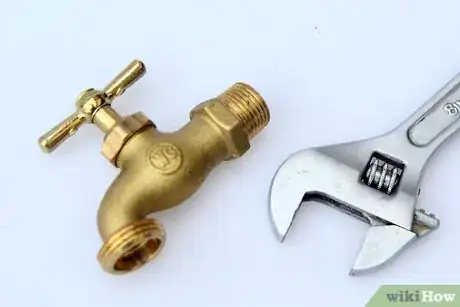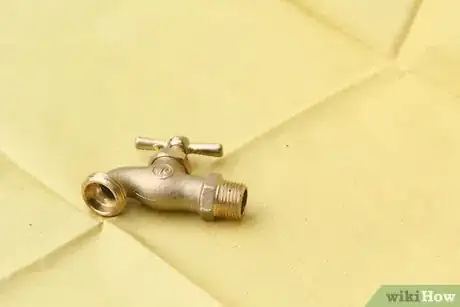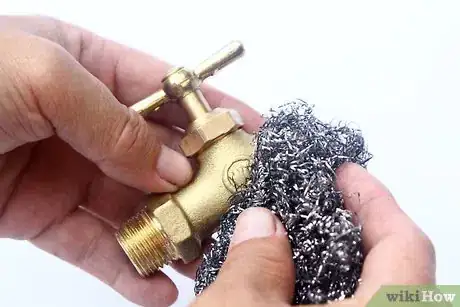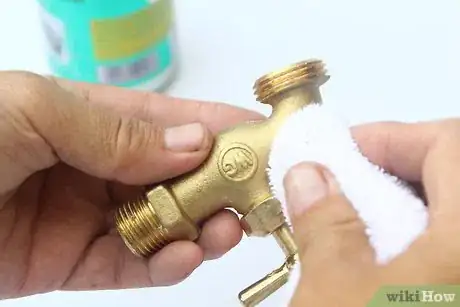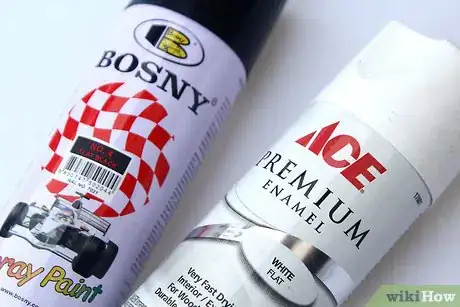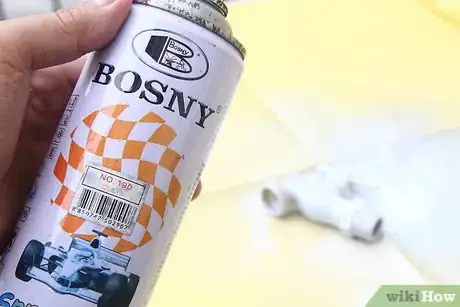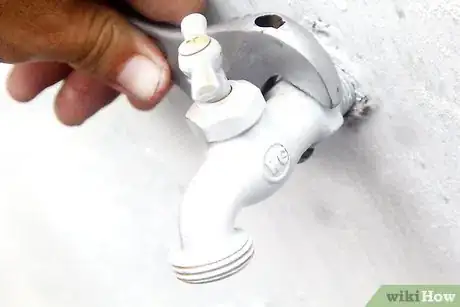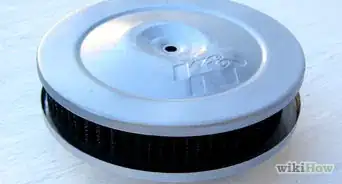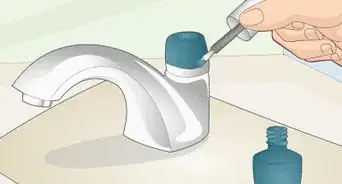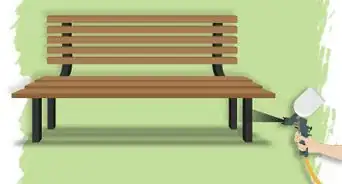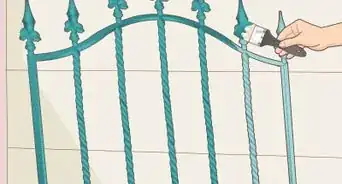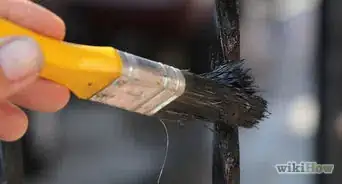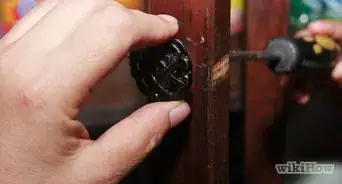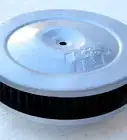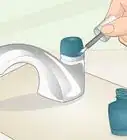This article was co-authored by James Guth. James Guth is the co-owner and founder of Chesapeake Painting Services LLC. With over 20 years of experience, James specializes in exterior and interior painting, drywall, powerwashing, wallpaper, staining, sealing, and carpentry. James holds a BS in Economics and Business Administration with a concentration in Finance from Towson University
There are 7 references cited in this article, which can be found at the bottom of the page.
wikiHow marks an article as reader-approved once it receives enough positive feedback. In this case, 96% of readers who voted found the article helpful, earning it our reader-approved status.
This article has been viewed 414,145 times.
Painting is a great way to touch things up and bring new life to objects. But when it comes to painting brass objects, such as lights, fixtures, and hardware, things get a little more difficult. It is possible to paint brass, however, and the trick is to properly clean and prime the metal before painting. This will provide a good surface for the paint to stick to, and make the painting job smoother, more even, and longer-lasting.
Steps
Getting the Surface Ready for Painting
-
1Remove the item if necessary. Some brass objects, such as door handles, faucets, and fixtures will be easier to paint if you remove them from where they are. Other objects, like furniture, utensils, and lamps, are already portable.
- If you removed any screws, nails, or other hardware, store them in a safe place so you can return the item after it’s painted.
- It’s also a good idea to test that your item is in fact brass. To test if something is brass, hold a magnet to it. Brass is a non-ferrous metal, meaning it contains no iron. As such, brass is also not magnetic, so a magnet will not be attracted to a brass object.
-
2Move the item to a well-ventilated area. All paint projects should be done in a well-ventilated area, such as a garage with doors or a room with large windows that open. This will protect you from paint fumes in addition to wearing a mask.[1]
- Place a drop cloth on the ground to protect the surrounding area from paint and splatter. Place the object you want to paint on top of the drop cloth, or on a work table or bench.
- Before you start painting, open windows and turn on any vents in the room to help remove paint fumes.
- Protect yourself with a mask, gloves, goggles, and other personal safety equipment when painting.
- Take measures to prevent dust from blowing around in the room.
Advertisement -
3Scrub the item with steel wool. One of the most important steps in painting brass is the scrubbing that happens beforehand. Not only does this help remove dirt and corrosion, but it also provides the paint with a good surface to stick to. [2] Rub the entire surface with the steel wool, concentrating on areas that are especially corroded or heavily soiled.[3]
- When you finished scrubbing the item, wipe it down with a damp, lint-free cloth.
- Paint needs a rough surface to stick to, which is why you want to scrub it with steel wool. Scrubbing brass with steel wool is not advisable unless you're preparing it for painting.
-
4Clean the surface with a degreaser. Removing oils, dirt, and grease from the surface of the metal before painting is integral. If there is oil, grease, or dirt left on the brass when you paint, the paint won’t adhere properly. Dampen a lint-free cloth with degreaser and wipe down the entire surface you wish to paint. Wipe the item again with a cloth damp with water, and set it aside for about 10 minutes to dry.
- Good degreasers for brass include liquid deglosser and solvents like butanone.[4]
Applying Primer and Paint
-
1Choose a spray paint in your desired color. Pick a paint that is suitable for metal, such as an enamel paint, an acrylic- or oil-based product, or another hard-drying paint. Most paints that are suitable for metal will be spray paints, but some may come in liquid (roll-on) form.
- Avoid latex paints for brass, as these don’t adhere as well to metal and aren't as durable. They may be usable if you have selected a high quality primer.
-
2Apply a coat of primer.[5] The best primer for brass is self-etching primer, also known as a bonding primer. This is a mixture of acid and zinc, and it will adhere better to the brass than any other type of paint or primer. Shake the primer well and hold it six to eight inches (15 to 20 cm) from the surface of the metal. Spray in a sweeping motion, going from side to side, and apply a thin, even coat of primer onto the surface.
- Let the primer dry for about 24 hours, or according to the manufacturer’s instructions.
- Wear all proper safety equipment when using spray paint, including gloves, safety glasses, and a mask.
- Even after scrubbing with steel wool, brass still doesn’t have a great surface for painting, which is why self-etching primer is important.[6]
-
3Apply several thin coats of paint. Once the primer has had time to dry, apply the paint in the same way. Shake the can, use a sweeping side to side motion, and hold the can six to eight inches (15 to 20 cm) from the surface to apply a thin, even coat.
- Let each coat dry completely according to the manufacturer’s instructions (usually an hour or two) before applying a second or third coat.[7]
- Depending on the effect you're trying to achieve, you may need anywhere between two and five coats of paint.
- If your paint came in a liquid form, use a brush or roller to apply thin, even coats.
-
4Apply a protective clear coat. Once the paint has had time to fully dry—usually about 24 hours—you can apply a clear top coat to finish the piece. This will help seal the piece, protect the paint, and make the finish shiny. Look for clear coats or enamel coats that are safe for metal.[8]
- Shake the can and hold it six to eight inches (15 to 20 cm) from the surface. Spray the coat in a back and forth motion to apply an even coat on the metal.
- Set the piece aside to dry according to the manufacturer’s instructions. These coats tend to dry quickly, sometimes in as little as 30 minutes.
Finishing the Job
-
1Transfer the dry item to a drying rack. After all the paint has dried to the touch, move the piece onto a drying rack. This will allow air to circulate around and under the piece and help it dry more quickly and evenly.
- Removing the piece from the position in which it was painted is also important to ensure it doesn’t stick to the drop cloth or work bench.
-
2Give the item time to cure. Once applied, paint generally has two phases that it goes through, and those are drying and curing. The paint may be dry within 30 minutes, but it still needs time to cure. Once the paint fully cures, it will be set, hard, and less prone to damage or dents.
- Depending on the type of paint you used, curing time could take anywhere from three to 30 days. Check the manufacturer’s instructions for specific curing times.[9]
- Giving the paint time to fully cure is especially important for fixtures, handles, utensils, and other brass pieces that will be handled often.
-
3Return the item to its original place. Once the paint has dried and cured, you can return the item, reinstall it, or put it back into regular use. Don’t forget to affix the piece properly using all the original screws, nails, and other hardware.
-
4Maintain your painted brass. The best way to keep your painted brass clean and new is to avoid touching it or banging it against other objects. For certain items, like wall fixtures, it will be easy to avoid contact. However, for things like furniture and door knobs, you can protect the brass and the paint by keeping it clean:[10]
- Wash the surface with a damp cloth and soapy water.
- Rinse the area with a clean, damp cloth.
- Towel dry the surface to remove excess water.
- Apply a fresh coat of paint as necessary to cover nicks and scratches.
Expert Q&A
Did you know you can get expert answers for this article?
Unlock expert answers by supporting wikiHow
-
QuestionHow do you prepare brass for painting?
 James GuthJames Guth is the co-owner and founder of Chesapeake Painting Services LLC. With over 20 years of experience, James specializes in exterior and interior painting, drywall, powerwashing, wallpaper, staining, sealing, and carpentry. James holds a BS in Economics and Business Administration with a concentration in Finance from Towson University
James GuthJames Guth is the co-owner and founder of Chesapeake Painting Services LLC. With over 20 years of experience, James specializes in exterior and interior painting, drywall, powerwashing, wallpaper, staining, sealing, and carpentry. James holds a BS in Economics and Business Administration with a concentration in Finance from Towson University
Commercial Painter
-
QuestionI'm looking to decoratively paint a trumpet. The lacquer has been stripped already. What kind of primer and paint can I use?
 Mark SpelmanMark Spelman is a General Contractor based in Austin, Texas. With over 30 years of construction experience, Mark specializes in constructing interiors, project management, and project estimation. He has been a construction professional since 1987.
Mark SpelmanMark Spelman is a General Contractor based in Austin, Texas. With over 30 years of construction experience, Mark specializes in constructing interiors, project management, and project estimation. He has been a construction professional since 1987.
Construction Professional
-
QuestionCan I paint a brass tray with gold metallic spraying paint?
 Mark SpelmanMark Spelman is a General Contractor based in Austin, Texas. With over 30 years of construction experience, Mark specializes in constructing interiors, project management, and project estimation. He has been a construction professional since 1987.
Mark SpelmanMark Spelman is a General Contractor based in Austin, Texas. With over 30 years of construction experience, Mark specializes in constructing interiors, project management, and project estimation. He has been a construction professional since 1987.
Construction Professional
Things You'll Need
- Drop cloth
- Brushes or mini-rollers
- Magnet
- Steel wool
- Lint-free cloths or rags
- Safety goggles, gloves, and mask
- Self-etching primer
- Metal-safe paint
- Metal-safe clear coat
References
- ↑ https://www.bobvila.com/articles/how-to-paint-metal/
- ↑ James Guth. Painting Specialist. Expert Interview. 21 July 2020.
- ↑ http://www.finishing.com/164/30.shtml
- ↑ http://www.younghouselove.com/2011/08/how-you-like-them-handles/
- ↑ James Guth. Painting Specialist. Expert Interview. 21 July 2020.
- ↑ http://www.finishing.com/188/48.shtml
- ↑ http://inmyownstyle.com/2012/06/how-to-update-a-brass-light-fixture-and-spray-painting-trick.html
- ↑ https://www.bobvila.com/articles/how-to-paint-metal/
- ↑ http://www.finishing.com/164/30.shtml
About This Article
Before you paint brass, scrub the item with steel wool to remove dirt and create a surface that paint can stick to. You'll also need to clean the surface with a degreaser like liquid deglosser. Next, apply a self-etching primer to your brass item to help the paint stick. Once the primer has had 24 hours to dry, apply a thin coat of enamel or acrylic paint in your chosen color. Let the coat dry according to the manufacturer's instructions before applying further coats. Finish by allowing the last coat to dry and applying a clear coat to seal the paint. For tips on how to cure the item and when to return it to its original place, keep reading!
